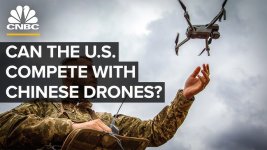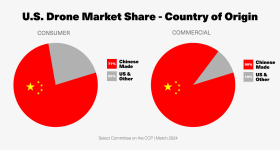Beijingwalker
Elite Member
- Nov 4, 2011
- 76,864
- 104,269
- Country of Origin

- Country of Residence

Why China’s dominance in commercial drones has become a global security matter

Whether you’ve flown a drone before or not, you’ve probably heard of DJI, or at least seen its logo. With more than a 90% share of the global consumer market, this Shenzhen-based company’s drones are used by hobbyists and businesses alike for photography and surveillance, as well as for spraying pesticides, moving parcels, and many other purposes around the world.
But on June 14, the US House of Representatives passed a bill that would completely ban DJI’s drones from being sold in the US. The bill is now being discussed in the Senate as part of the annual defense budget negotiations.
The reason? While its market dominance has attracted scrutiny for years, it’s increasingly clear that DJI’s commercial products are so good and affordable they are also being used on active battlefields to scout out the enemy or carry bombs. As the US worries about the potential for conflict between China and Taiwan, the military implications of DJI’s commercial drones are becoming a top policy concern.
DJI has managed to set the gold standard for commercial drones because it is built on decades of electronic manufacturing prowess and policy support in Shenzhen. It is an example of how China’s manufacturing advantage can turn into a technological one.
“I’ve been to the DJI factory many times … and mainly, China’s industrial base is so deep that every component ends up being a fraction of the cost,” Sam Schmitz, the mechanical engineering lead at Neuralink, wrote on X. Shenzhen and surrounding towns have had a robust factory scene for decades, providing an indispensable supply chain for a hardware industry like drones. “This factory made almost everything, and it’s surrounded by thousands of factories that make everything else … nowhere else in the world can you run out of some weird screw and just walk down the street until you find someone selling thousands of them,” he wrote.
But Shenzhen’s municipal government has also significantly contributed to the industry. For example, it has granted companies more permission for potentially risky experiments and set up subsidies and policy support. Last year, I visited Shenzhen to experience how it’s already incorporating drones in everyday food delivery, but the city is also working with companies to use drones for bigger and bigger jobs—carrying everything from packages to passengers. All of these go into a plan to build up the “low-altitude economy” in Shenzhen that keeps the city on the leading edge of drone technology.
As a result, the supply chain in Shenzhen has become so competitive that the world can’t really use drones without it. Chinese drones are simply the most accessible and affordable out there.
Most recently, DJI’s drones have been used by both sides in the Ukraine-Russia conflict for reconnaissance and bombing. Some American companies tried to replace DJI’s role, but their drones were more expensive and their performance unsatisfactory. And even as DJI publicly suspended its businesses in Russia and Ukraine and said it would terminate any reseller relationship if its products were found to be used for military purposes, the Ukrainian army is still assembling its own drones with parts sourced from China.
This reliance on one Chinese company and the supply chain behind it is what worries US politicians, but the danger would be more pronounced in any conflict between China and Taiwan, a prospect that is a huge security concern in the US and globally.
Last week, my colleague James O’Donnell wrote about a report by the think tank Center for a New American Security (CNAS) that analyzed the role of drones in a potential war in the Taiwan Strait. Right now, both Ukraine and Russia are still finding ways to source drones or drone parts from Chinese companies, but it’d be much harder for Taiwan to do so, since it would be in China’s interest to block its opponent’s supply. “So Taiwan is effectively cut off from the world’s foremost commercial drone supplier and must either make its own drones or find alternative manufacturers, likely in the US,” James wrote.
If the ban on DJI sales in the US is eventually passed, it will hit the company hard for sure, as the US drone market is currently worth an estimated $6 billion, the majority of which is going to DJI. But undercutting DJI’s advantage won’t magically grow an alternative drone industry outside China.
“The actions taken against DJI suggest protectionism and undermine the principles of fair competition and an open market. The Countering CCP Drones Act risks setting a dangerous precedent, where unfounded allegations dictate public policy, potentially jeopardizing the economic well-being of the US,” DJI told MIT Technology Review in an emailed statement.
The Taiwanese government is aware of the risks of relying too much on China’s drone industry, and it’s looking to change. In March, Taiwan’s newly elected president, Lai Ching-te, said that Taiwan wants to become the “Asian center for the democratic drone supply chain.”
Already the hub of global semiconductor production, Taiwan seems well positioned to grow another hardware industry like drones, but it will probably still take years or even decades to build the economies of scale seen in Shenzhen. With support from the US, can Taiwanese companies really grow fast enough to meaningfully sway China’s control of the industry? That’s a very open question.
DJI’s commercial-use drones are affordable and powerful, but their applications in a war zone have raised concerns in the US and beyond.
June 26, 2024
Whether you’ve flown a drone before or not, you’ve probably heard of DJI, or at least seen its logo. With more than a 90% share of the global consumer market, this Shenzhen-based company’s drones are used by hobbyists and businesses alike for photography and surveillance, as well as for spraying pesticides, moving parcels, and many other purposes around the world.
But on June 14, the US House of Representatives passed a bill that would completely ban DJI’s drones from being sold in the US. The bill is now being discussed in the Senate as part of the annual defense budget negotiations.
The reason? While its market dominance has attracted scrutiny for years, it’s increasingly clear that DJI’s commercial products are so good and affordable they are also being used on active battlefields to scout out the enemy or carry bombs. As the US worries about the potential for conflict between China and Taiwan, the military implications of DJI’s commercial drones are becoming a top policy concern.
DJI has managed to set the gold standard for commercial drones because it is built on decades of electronic manufacturing prowess and policy support in Shenzhen. It is an example of how China’s manufacturing advantage can turn into a technological one.
“I’ve been to the DJI factory many times … and mainly, China’s industrial base is so deep that every component ends up being a fraction of the cost,” Sam Schmitz, the mechanical engineering lead at Neuralink, wrote on X. Shenzhen and surrounding towns have had a robust factory scene for decades, providing an indispensable supply chain for a hardware industry like drones. “This factory made almost everything, and it’s surrounded by thousands of factories that make everything else … nowhere else in the world can you run out of some weird screw and just walk down the street until you find someone selling thousands of them,” he wrote.
But Shenzhen’s municipal government has also significantly contributed to the industry. For example, it has granted companies more permission for potentially risky experiments and set up subsidies and policy support. Last year, I visited Shenzhen to experience how it’s already incorporating drones in everyday food delivery, but the city is also working with companies to use drones for bigger and bigger jobs—carrying everything from packages to passengers. All of these go into a plan to build up the “low-altitude economy” in Shenzhen that keeps the city on the leading edge of drone technology.
As a result, the supply chain in Shenzhen has become so competitive that the world can’t really use drones without it. Chinese drones are simply the most accessible and affordable out there.
Most recently, DJI’s drones have been used by both sides in the Ukraine-Russia conflict for reconnaissance and bombing. Some American companies tried to replace DJI’s role, but their drones were more expensive and their performance unsatisfactory. And even as DJI publicly suspended its businesses in Russia and Ukraine and said it would terminate any reseller relationship if its products were found to be used for military purposes, the Ukrainian army is still assembling its own drones with parts sourced from China.
This reliance on one Chinese company and the supply chain behind it is what worries US politicians, but the danger would be more pronounced in any conflict between China and Taiwan, a prospect that is a huge security concern in the US and globally.
Last week, my colleague James O’Donnell wrote about a report by the think tank Center for a New American Security (CNAS) that analyzed the role of drones in a potential war in the Taiwan Strait. Right now, both Ukraine and Russia are still finding ways to source drones or drone parts from Chinese companies, but it’d be much harder for Taiwan to do so, since it would be in China’s interest to block its opponent’s supply. “So Taiwan is effectively cut off from the world’s foremost commercial drone supplier and must either make its own drones or find alternative manufacturers, likely in the US,” James wrote.
If the ban on DJI sales in the US is eventually passed, it will hit the company hard for sure, as the US drone market is currently worth an estimated $6 billion, the majority of which is going to DJI. But undercutting DJI’s advantage won’t magically grow an alternative drone industry outside China.
“The actions taken against DJI suggest protectionism and undermine the principles of fair competition and an open market. The Countering CCP Drones Act risks setting a dangerous precedent, where unfounded allegations dictate public policy, potentially jeopardizing the economic well-being of the US,” DJI told MIT Technology Review in an emailed statement.
The Taiwanese government is aware of the risks of relying too much on China’s drone industry, and it’s looking to change. In March, Taiwan’s newly elected president, Lai Ching-te, said that Taiwan wants to become the “Asian center for the democratic drone supply chain.”
Already the hub of global semiconductor production, Taiwan seems well positioned to grow another hardware industry like drones, but it will probably still take years or even decades to build the economies of scale seen in Shenzhen. With support from the US, can Taiwanese companies really grow fast enough to meaningfully sway China’s control of the industry? That’s a very open question.











